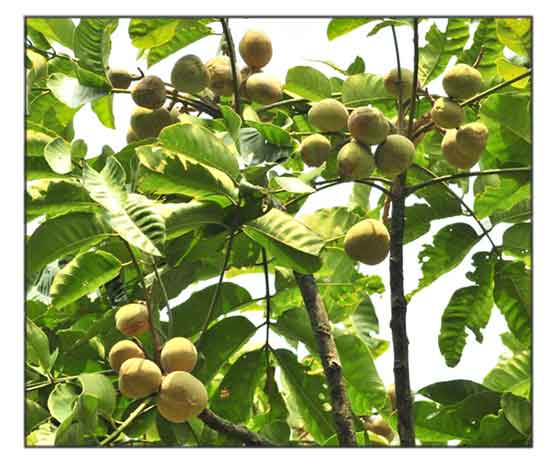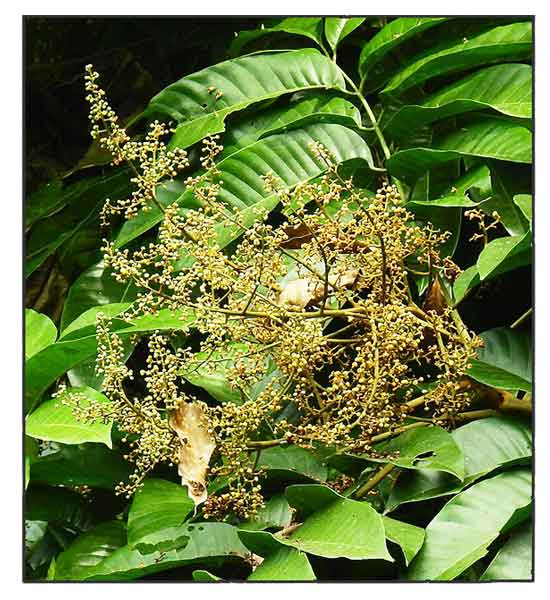Gen info
- Aglaia is a genus of 121 recognized species of wood dioecious trees in the mahogany family Meliaceae.
-
Aglaia spectabilis is a species of tree in the family Meliaceae.
- The species was described by two botanists: S.S. Jain (1952-) and Sigamony Stephen Riichard Bennet (1940-2009). (2)
 Botany Botany
• Trees to 18 m tall. Leaves alternate; petiole and rachis ca. 35 cm; petiole glabrous, abaxially rounded, adaxially with a shallow groove; leaflets 11, opposite; petiolules 1-1.5 cm, thick, adaxially sulcate and stellately lepidote; leaflet blades oblong-elliptic, both surfaces ± glabrous, secondary veins 14-16 on each side of midvein, abaxially conspicuously prominent, and adaxially depressed, reticulate veins abaxially subprominent, base truncate to rounded, margin reflexed, apex acuminate. Thyrses axillary, 20-25 cm, stellately lepidote, branches thick and often pendulous. Flower buds ovoid, ca. 6 mm. Pedicel 2-4 mm, apex nodiferous. Calyx 3-lobed; lobes broadly triangular, outside stellately lepidote. Petals 3, ovate, 5-6 mm, outside densely stellately lepidote, inside concave and glabrous. Staminal tube urceolate, ca. 3 mm, glabrous, apical margin 10-lobed; anthers 10, linear to oblong, included. Ovary ovoid, 3-locular, densely covered with yellowish pubescence; stigma triquetrous to conical, base sulcate, apex 3-dentate. Fruit dehiscent, obovoid to pyriform, 3-locular, with 1 seed per locule, pubescent and sparsely stellately lepidote; stipe to 4 mm in diam. (Flora of China)
 • Aglaia spectabilis grows as a tree to 40 m tall. Tree trunk has large plank-like buttresses, with a grayish-white to brown bark that flakes in squarish large scales. When the trunk is cut to reveal inner bark and wood, a meager milky exudate exudes from the fine layers in the blaze, with a faint odor of incense often apparent. Twigs and leaves also produce milk. Reddish-brown to pale-brown stellate hairs of scales densely cover the twigs, petioles, rachis, petiolules, inflorescences, infructescences, calyxes, and outside of petals and fruits. Lower leaflet surface has a variable cover of hairs, from few to many. Rather large blade on lateral leaflets, from as little as 3cm, though usually 9–40 cm long and some 3–17 cm wide, with the subprominent lateral veins curving inside the margin, but they do not form loops. Leaves are quite large, some 50-135 cm long. The inflorescences are up to 40 cm long. Flowers are small; some 2-7 by 2-6 mm in size; lobes of the calyx are rounded at the apex with their outer surface densely clothed in stellate hairs; the 3 pinkish-yellow petals are partially clothed; about 9 stamens; cup-shaped staminal tube roughly 3mm long, 2.5mm wide; protruding beyond the aperture are 6 anthers. Infructescence is some 9-13cm long. In the dehiscent, subglobose to obovoid fruit, the red aril/sarcotesta completely encloses the seed; size of fruit is roughly 6-9 by 5.5-9 cm; up to 1cm thick pericarp with white latex or milk; 3 locules each of which have 1 or 0 seeds. Seed (5-6mm long) germination occurs in 20-28 days. In the roughly paraboloid-shaped cotyledons of the seedling, the face of the cotyledon forms base of paraboloid, the face is in a plane at right angles with the seed's long axis. Primary pair of leaves roughly 10-15cm long. The terminal bud is clothed in stellate hairs or scales at the 10th leaf stage. (2) • Aglaia spectabilis grows as a tree to 40 m tall. Tree trunk has large plank-like buttresses, with a grayish-white to brown bark that flakes in squarish large scales. When the trunk is cut to reveal inner bark and wood, a meager milky exudate exudes from the fine layers in the blaze, with a faint odor of incense often apparent. Twigs and leaves also produce milk. Reddish-brown to pale-brown stellate hairs of scales densely cover the twigs, petioles, rachis, petiolules, inflorescences, infructescences, calyxes, and outside of petals and fruits. Lower leaflet surface has a variable cover of hairs, from few to many. Rather large blade on lateral leaflets, from as little as 3cm, though usually 9–40 cm long and some 3–17 cm wide, with the subprominent lateral veins curving inside the margin, but they do not form loops. Leaves are quite large, some 50-135 cm long. The inflorescences are up to 40 cm long. Flowers are small; some 2-7 by 2-6 mm in size; lobes of the calyx are rounded at the apex with their outer surface densely clothed in stellate hairs; the 3 pinkish-yellow petals are partially clothed; about 9 stamens; cup-shaped staminal tube roughly 3mm long, 2.5mm wide; protruding beyond the aperture are 6 anthers. Infructescence is some 9-13cm long. In the dehiscent, subglobose to obovoid fruit, the red aril/sarcotesta completely encloses the seed; size of fruit is roughly 6-9 by 5.5-9 cm; up to 1cm thick pericarp with white latex or milk; 3 locules each of which have 1 or 0 seeds. Seed (5-6mm long) germination occurs in 20-28 days. In the roughly paraboloid-shaped cotyledons of the seedling, the face of the cotyledon forms base of paraboloid, the face is in a plane at right angles with the seed's long axis. Primary pair of leaves roughly 10-15cm long. The terminal bud is clothed in stellate hairs or scales at the 10th leaf stage. (2)
Distribution
- Native to the Philippines.
- Also native to Andaman Is., Assam, Bangladesh, Bismarck Archipelago, Borneo, Cambodia, China South-Central, East Himalaya, India, Laos, Lesser Sunda Is., Malaya, Myanmar, New Guinea, Queensland, Santa Cruz Is., Solomon Is., Sulawesi, Sumatera, Thailand, Vietnam. (1)
Constituents
- Study of bark of A. spectabilis yielded 11 insecticidal cyclopentatetrahydrobenzo-furans of the rocaglamide type including four new natural products. (see study below) (4)
Properties
- Very find sawdust can cause dermatitis.
-
Study showed insecticidal properties.
Parts used
Roots, leaves, bark.
 Uses Uses
Edibility
- Fruits are edible.
Folkloric
- No reported folkloric medicinal use in the Philippines.
- Plant is used as tonic, acting on the spleen. Boiled roots used to cure indigestion. Used as folk remedy for treatment of boils, hemorrhages, sores, cancer, spleen problems, and wounds. Roots and/or shoots applied as styptic to wounds. (3)
-
In India, pounded leaves applied as poultice for stomachache and other abdominal maladies. Ethnic communities of Assam use cold or hot infusion of leaves and fruits to treat worm infection. Leaf infusion used to treat fever, skin allergies, and diarrhea. Bark infusion used to treat cough. (3) The Bangni people of East Kameng District, Arunachal Pradesh, India, eat the raw fruit for relief of coughing.
Others
- Wood: Wood is hard and close-grained. Superior quality timber of red color, used for making furniture, wall paneling, boat building, boards, cabinetry, plywood, veneer, turning, tools, and tool handles. Larger roots and buttresses used to make oxen-cart wheels. (3)
- Fish poison: Crushed fresh bark used as fish poison. (3)
- Dye: Fruits and leaves boiled to make a black dye.
- Oil: Seeds yield a brown oil.
Studies
• Insecticidal / Bark: Rocaglamide derivatives are powerful natural insecticides. Study of bark of A. spectabilis yielded 11 insecticidal cyclopentatetrahydrobenzo-furans of the rocaglamide type including four new natural products. All rocaglamide derivatives isolated exhibited strong insecticidal activity towards neonate larvae of the polyphagous pest insect Spodoptera littoralis when incorporated into an artifical diet. LC50s ranged from 0.8 to 80 ppm. The most active was methylrocaglate and C-3' hydroxymethylrocaglate, with insecticidal activity similar to natural insecticide azadirachtin. (4)
Availability
Wild-crafted. |

![]()




 • Aglaia spectabilis grows as a tree to 40 m tall. Tree trunk has large plank-like buttresses, with a grayish-white to brown bark that flakes in squarish large scales. When the trunk is cut to reveal inner bark and wood, a meager milky exudate exudes from the fine layers in the blaze, with a faint odor of incense often apparent. Twigs and leaves also produce milk. Reddish-brown to pale-brown stellate hairs of scales densely cover the twigs, petioles, rachis, petiolules, inflorescences, infructescences, calyxes, and outside of petals and fruits. Lower leaflet surface has a variable cover of hairs, from few to many. Rather large blade on lateral leaflets, from as little as 3cm, though usually 9–40 cm long and some 3–17 cm wide, with the subprominent lateral veins curving inside the margin, but they do not form loops. Leaves are quite large, some 50-135 cm long. The inflorescences are up to 40 cm long. Flowers are small; some 2-7 by 2-6 mm in size; lobes of the calyx are rounded at the apex with their outer surface densely clothed in stellate hairs; the 3 pinkish-yellow petals are partially clothed; about 9 stamens; cup-shaped staminal tube roughly 3mm long, 2.5mm wide; protruding beyond the aperture are 6 anthers. Infructescence is some 9-13cm long. In the dehiscent, subglobose to obovoid fruit, the red aril/sarcotesta completely encloses the seed; size of fruit is roughly 6-9 by 5.5-9 cm; up to 1cm thick pericarp with white latex or milk; 3 locules each of which have 1 or 0 seeds. Seed (5-6mm long) germination occurs in 20-28 days. In the roughly paraboloid-shaped cotyledons of the seedling, the face of the cotyledon forms base of paraboloid, the face is in a plane at right angles with the seed's long axis. Primary pair of leaves roughly 10-15cm long. The terminal bud is clothed in stellate hairs or scales at the 10th leaf stage. (
• Aglaia spectabilis grows as a tree to 40 m tall. Tree trunk has large plank-like buttresses, with a grayish-white to brown bark that flakes in squarish large scales. When the trunk is cut to reveal inner bark and wood, a meager milky exudate exudes from the fine layers in the blaze, with a faint odor of incense often apparent. Twigs and leaves also produce milk. Reddish-brown to pale-brown stellate hairs of scales densely cover the twigs, petioles, rachis, petiolules, inflorescences, infructescences, calyxes, and outside of petals and fruits. Lower leaflet surface has a variable cover of hairs, from few to many. Rather large blade on lateral leaflets, from as little as 3cm, though usually 9–40 cm long and some 3–17 cm wide, with the subprominent lateral veins curving inside the margin, but they do not form loops. Leaves are quite large, some 50-135 cm long. The inflorescences are up to 40 cm long. Flowers are small; some 2-7 by 2-6 mm in size; lobes of the calyx are rounded at the apex with their outer surface densely clothed in stellate hairs; the 3 pinkish-yellow petals are partially clothed; about 9 stamens; cup-shaped staminal tube roughly 3mm long, 2.5mm wide; protruding beyond the aperture are 6 anthers. Infructescence is some 9-13cm long. In the dehiscent, subglobose to obovoid fruit, the red aril/sarcotesta completely encloses the seed; size of fruit is roughly 6-9 by 5.5-9 cm; up to 1cm thick pericarp with white latex or milk; 3 locules each of which have 1 or 0 seeds. Seed (5-6mm long) germination occurs in 20-28 days. In the roughly paraboloid-shaped cotyledons of the seedling, the face of the cotyledon forms base of paraboloid, the face is in a plane at right angles with the seed's long axis. Primary pair of leaves roughly 10-15cm long. The terminal bud is clothed in stellate hairs or scales at the 10th leaf stage. (
